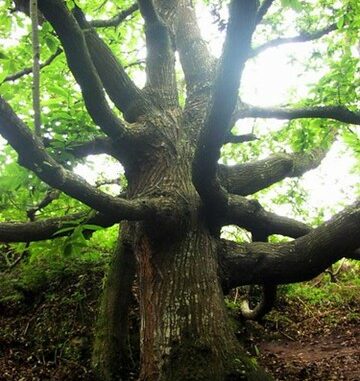
 By Jessica Clarke, Horticulturist | Gardens on Spring Creek
By Jessica Clarke, Horticulturist | Gardens on Spring Creek
The tradition of the Christmas tree is quite peculiar; participants go out of their way to bring a huge, water-dependent plant indoors, knowing that it will likely only last a month or two at most. They then throw little toy-like pieces onto the plant’s branches and light it up.
In the United States alone, 25 to 30 million Christmas trees are sold each year.
That’s a lot of people carrying on this strange practice. But where does this odd custom come from? This little yearly ritual can be traced back hundreds, even thousands, of years and across many different cultures’ worship of trees.
For example, the Yggdrasil, in Norse mythology, is an ash tree whose branches stretch out to hold nine worlds and whose three tree roots also reach out to different locales.
Throughout North America, Native Americans have mythologies and beliefs that center around the cedar tree. In Mesoamerica, the Ceiba tree is the sacred tree of life and also symbolizes the universe.
The Celtic tree of life, or Crann Bethadh, is often represented by an oak tree and is looked upon for wisdom and strength. For many cultures around the world, trees represent birth, death, and the center of the universe.

The green leaves on deciduous trees during the rebirth phase are what inspired many people to bring in evergreens during the cold, dark, “death” portion of the year. It was believed that by bringing in this greenery, they would encourage the rebirth of the sun, which would then bring back the crops and “life” to the earth.
Germanic peoples did this annually around the winter solstice, from where the now traditional Christmas tree origins grew. Legend has it in the 16th century, Martin Luther was walking outside on a winter’s night and saw stars twinkling amongst the evergreens. To replicate this scene, he placed an evergreen tree in his home and wired candles to the branches that were lighted.
From there, the Christmas tree started to gain popularity throughout the German territories. Some areas even banned Christmas trees, declaring the tree was too pagan. It would take until the 19th century for Christmas trees to catch on at a global scale.
By the mid-20th century, just about every household in the U.S. would have a Christmas tree. This widespread and old tradition gives a good example of our relationship to plants and especially trees. Maybe this holiday, while you are sitting around your Christmas tree, reflect on your history with trees and what they mean to you.
Support Northern Colorado Journalism
Show your support for North Forty News by helping us produce more content. It's a kind and simple gesture that will help us continue to bring more content to you.
BONUS - Donors get a link in their receipt to sign up for our once-per-week instant text messaging alert. Get your e-copy of North Forty News the moment it is released!
Click to Donate
